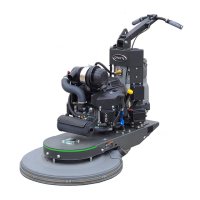42 43
CARBON MONOXIDE (CO) SAFETY
This machine and the engine that powers it have been specically calibrated to operate safely in indoor
spaces. This is accomplished by calibrating the engine to run with a very “lean” air/fuel ratio which minimiz-
es the production of carbon monoxide. Additionally, a catalyst muer is provided with the engine which
specically targets and eliminates carbon monoxide.
In order to maintain a safe working environment, and minimize risk of carbon monoxide poisoning, the
following safety information and instruction in this section must be strictly adhered to:
DANGER: All LPG (Liquid Propane Gas) powered engines, including this engine, produce
Carbon Monoxide (CO), a DEADLY, colorless, odorless, tasteless, non-irritating, and poisonous
gas. Failure to provide for proper venting of CO produced during the operation of combustion
powered engines may result in SERIOUS INJURY OR DEATH to the operator and those in the
contaminated area.
DANGER: Do not operate this machine without catalyst muer installed.
DANGER: Do not tamper with regulator or other settings which would alter air/fuel ratio.
WARNING: Dangerous carbon monoxide emissions from this engine will increase greatly due to
a dirty air cleaner. Follow the engine manufacturer’s air cleaner service instructions.
The purpose of this section is to provide helpful information to explain how carbon monoxide can be
managed to reduce risk of carbon monoxide poisoning:
• Potential eects of CO exposure
• Industry guidelines for acceptable CO exposure
• Measuring CO exposure
• Understanding factors that determine CO exposure
• Methods to reduce CO exposure
POTENTIAL EFFECTS OF CARBON MONOXIDE EXPOSURE
DANGER: Symptoms of carbon monoxide (CO) poisoning include headaches, irritability,
confusion, dizziness, drowsiness, visual disturbance, nausea, vomiting, asphyxiation, or lack of
consciousness. If you or any bystander experience any of these symptoms, shut o the machine
immediately and go outside for fresh air. Do NOT operate the machine again until it has been
tested by a qualied technician.
The toxic eects of carbon monoxide in the blood are the result of tissue hypoxia (lack of oxygen). Carbon
monoxide combines with hemoglobin to form carboxyhemoglobin. Since CO and oxygen react with the
same group in the hemoglobin molecule, carboxyhemoglobin is incapable of carrying Oxygen. The anity
of hemoglobin for CO is 200 to 240 times greater than for oxygen. The extent of saturation of hemoglo-
bin with CO depends on the concentration of the gas, the quantity of inspired air and on the time of expo-
sure. The severity depends on the state of activity of the individual and his tissue oxygen needs.
The eects of CO can be experienced at dierent exposure levels, depending on the health of the individ-
ual. Conditions that aect the tolerance of the individual are smoking, age, temperature, humidity, and
other conditions.
According to Harrison’s Principles of Internal Medicine 7th edition:
• No symptoms will develop at a concentration of 0.01 % CO (100ppm) in inspired air, since this will not
raise blood saturation above 10 %.
• Exposure to 0.05% (500ppm) for 1 hour during light activity will produce a blood concentration of 20%
carboxyhemoglobin and result in a mild or throbbing headache.
• Greater activity or longer exposure causes a blood saturation of 30 to 50 %. At this point head ache, irri-
tability, confusion, dizziness, visual disturbance, nausea, vomiting, and fainting can be experienced.
• Exposure for one hour to concentrations of 0.1 % (1000ppm) in inspired air the blood will contain 50 to
80% carboxyhemoglobin which results in coma, convulsions, respiratory failure and death.
• On inhalation of high concentrations of CO, saturation of the blood proceeds so rapidly that uncon-
sciousness may occur suddenly without warning.
INDUSTRY GUIDELINES FOR ACCEPTABLE
CARBON MONOXIDE EXPOSURE
Limits for permissible exposure to Carbon Monoxide vary substantially from region to region. Consult
local, regional, and national workplace safety standards to determine limits for carbon monoxide exposure
in your area, prior to use of any propane machines.
The current Occupational Safety and Health Administration (OSHA) Permissible Exposure Limit (PEL)
for CO is 35 ppm, as an 8-hour time weighted average (TWA). This is computed by making measurements
at intervals over 8 hours, then adding the sums of the concentrations and the intervals, and dividing by 8
hours. For example:
Time
8:00-9:00
9:00-10:00
10:00-11:00
11:00-12:00
12:00-1:00
1:00-2:00
2:00-3:00
3:00-4:00
Interval
1 HR
1 HR
1 HR
1 HR
1 HR
1 HR
1 HR
1 HR
PPM
100
25
25
50
50
50
50
50
Time intervals = 8 HR
Total ppm = 400
Time Weighted Average (TWA) = 400 ppm / 8 HR = 50 PPM/Hr
The current National Institute for Occupational Health and Safety (NIOSH) has determined that
concentrations above the 1,200 ppm is “immediately dangerous to life and health” (IDLH). NIOSH
denes the IDLH exposure level as the concentration that could result in irreversible health eects
or death, or prevent escape from the contaminated environment within 30 minutes.
POTENTIAL EFFECTS OF CARBON MONOXIDE EXPOSURE

